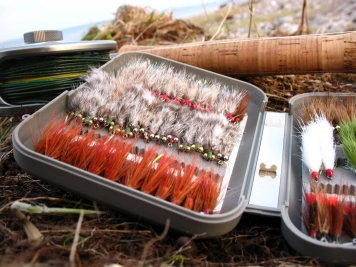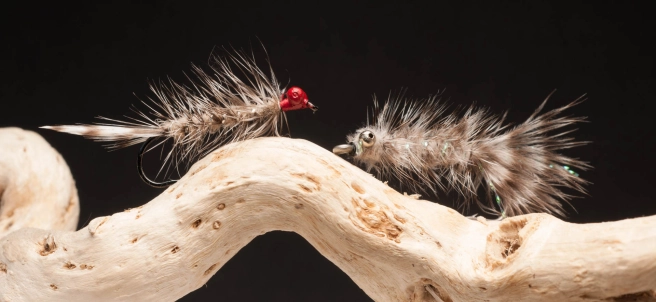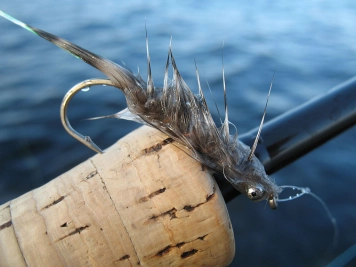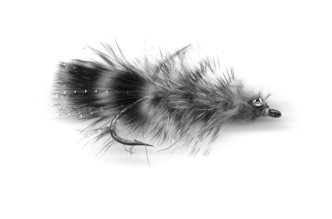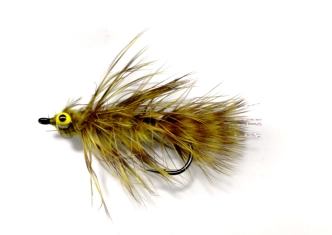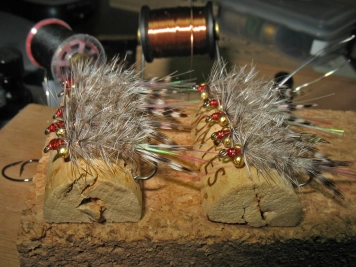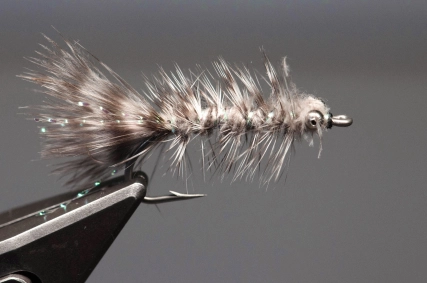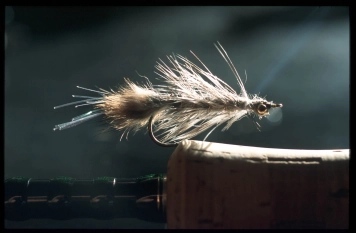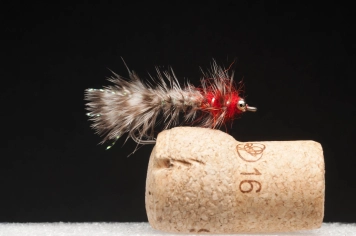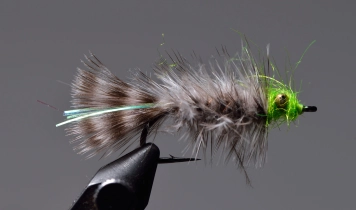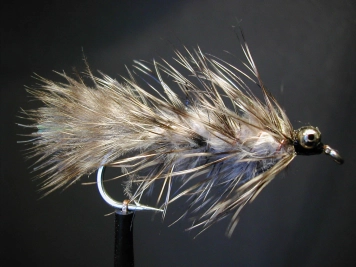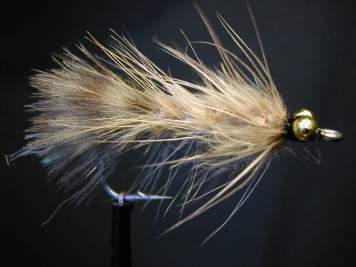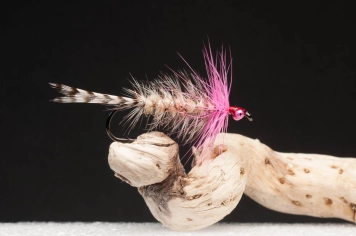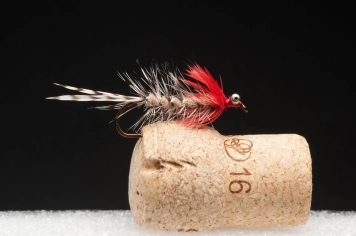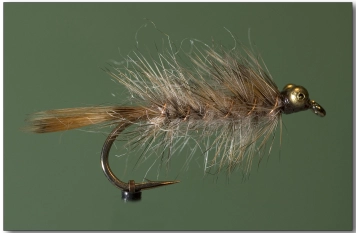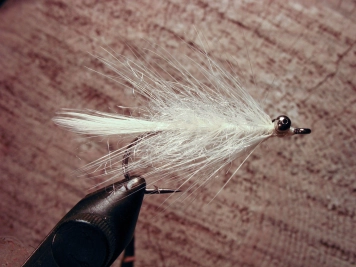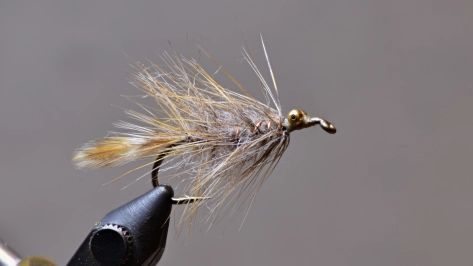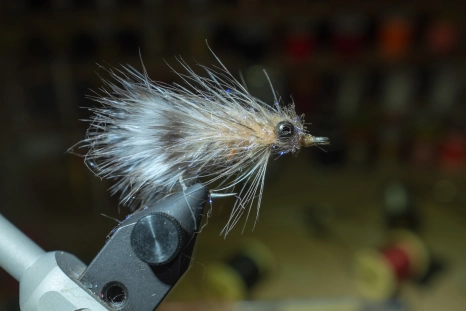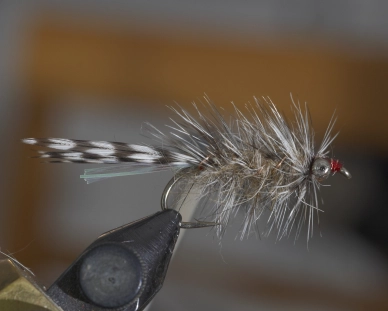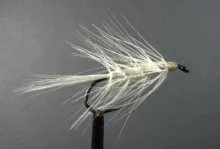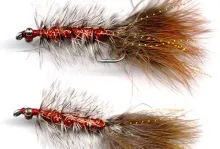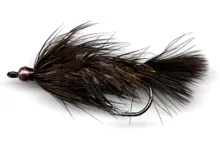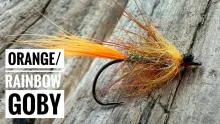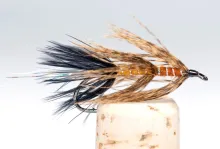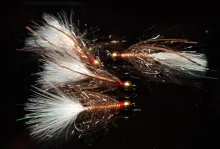The classical Danish coastal flies Magnus and Grey Fred have been an inspiration for many derivative patterns as well as hybrids. This is their story.
The two Danish sea trout patterns Magnus and Grey Fred are both true classics in this small part of the world. They are similar but still different, both based on a Woolly Bugger style fly, both being nondescript gray and grizzly and both able to imitate a wealth of prey animals including shrimps and small fish.
The Magnus ([maw'nes]) is a fly, which is close to its 50th anniversary and is one of the all time classic coastal flies for sea trout. Tied for the first time in 1973 by Danish coastal fly angler Magnus Ting Mortensen, it's stood the test of time, and is still on the inventory of all Danish flyshops and found in some variation in most Danish coastal fly boxes. Read the full story here.
The Grey Fred (Grå Frede, [gro' fraythe]) is a later pattern, but still has a history that can be traced back to 1989, where it was first tied by Danish angler Peter Løvendahl together with his friend Lars Meincke. It might look similar to the Magnus at first glance, being a gray fly with a grizzly body hackle, but it uses different materials, is tied differently and does appear and act differently in the water.
What's in a name?
These two patterns in their "clean" versions have been responsible for a very large number of sea trout catches, and are still found in a lot of fly boxes on the Baltic coasts. They are some of the best, most universal and generic flies that you can tie for sea run sea trout – and even easy to tie. Still, an amazing number of variations have been made. Some on purpose with new names, many just because people tie the flies differently than originally described, a lot because people confuse patterns and materials, and quite a few because people can't tie worth *beep*.
If you look in Danish Thomas Vinge's books "Sea Trout on the Coast", which covers a large number of Danish sea trout flies, you will find a large number of flies that look like the Fred and Magnus. Names like "Tickerfly", "Tyskeren" (The German), "Bjarke", "Hundestedfluen" (The Fly from Hundested), "Dræberrejen" (Killer Shrimp), "Flaskerenser" (Bottle Cleaner), "Pace", "Negeren" and many more all cover flies, which look in one way or the other like the Danish Classics.
Naming seems almost random, and you will find people tying almost genuine Grey Fred's and calling them Magnus and vice versa. The variations basically seem to be randomly named after one or the other.
If you tie a fly, and it looks remotely like one of these two, I suggest that you use an anagram game to name it The letters in Magnus Fred can actually also form the names Gus Manfred, so there are two obvious names. You can take the game a step further and get names like "Dung Frames", "Farmed Guns", "Gamers' Fund", "Framed Snug", "Fume Grands" and many, many more. How about "Mars Dungefe"... If covfefe works, so does dungefe, I suppose.
If covfefe works, so does dungefe, I suppose.
The similarities
Let me try to set things straight regarding these patterns, by listing the similarities and differences between what I have tied to establish to the best of my abilities as the original versions of both flies.
- They are the same basic colors: dull gray with grizzly hackle.
- They both have a dubbed body, palmer hackled and ribbed.
- They both have bead chain eyes.
- The flies are basically the same size and proportions, mostly being tied on fairly long hooks in size 6, 4 or 2.
The differences
Below you see the main differences between the Grey Fred (left) and the Magnus (right), both tied fairly close to the original style. They may look superficially the same - essentially a gray Woolly Bugger - but there are distinct differences, both in materials, tying style, appearance and behavior in the water.
Curved, straight eye hook
Body is chickabou dubbing
Flash in tail, body and head
Short, even hackle
Rib is twisted flash
Head dubbed between eyes
Straight, down eye hook
Body is hare's wool
No flash anywhere
Tapered hackles, front/body
Rib is oval silver tinsel
Head and eyes varnished red
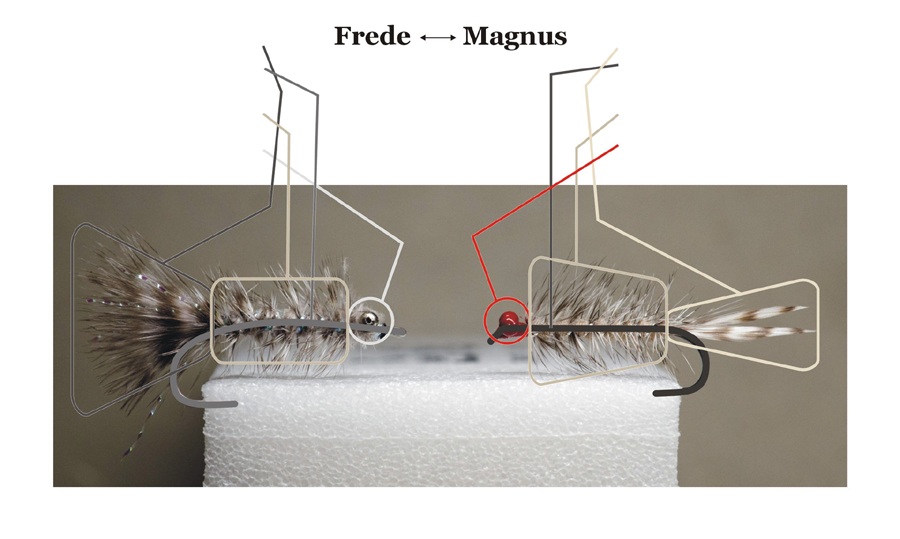
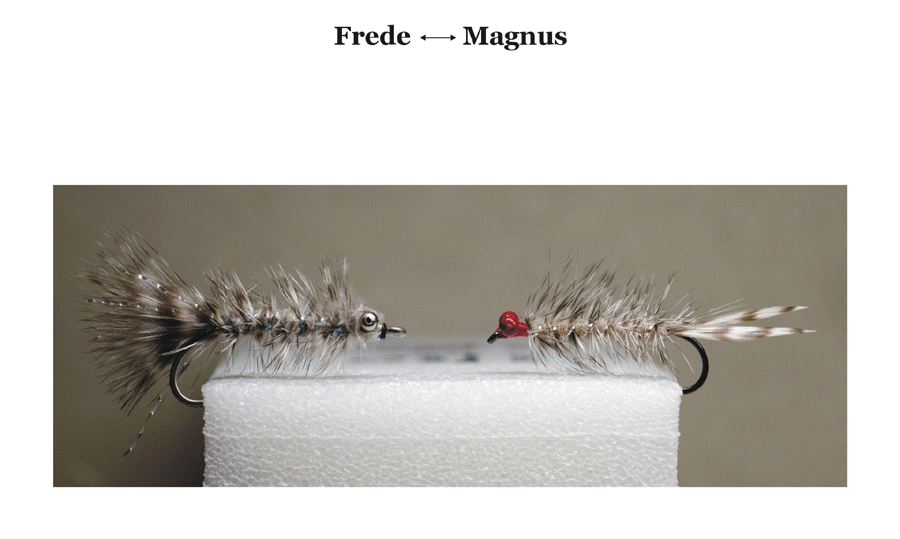
The hybridization
Being fairly close in appearance and use, the two flies have been interbred many, many times. The most common mixup is using the Fred's marabou tail on flies called Magnus. The tail style on the two flies is one of the things that set them apart.
You will also see flies called Fred that sport a larger front hackle. The original did not have a separate front hackle, but only a fairly short fibered, even body hackle.
Personally I like to see credit where credit is due, and if your fly is tied like and looks like a Fred, don't call it Magnus! And if your fly is tied like neither… find a new name.
Color variations
It's of course pretty obvious to simply change the material colors, which is the most straightforward way of creating a derivation of any fly. I haven't brought all the many color variation clan members into the article as separate patterns, but you see quite a few in the images. Especially the Fred has been tied in different colors with the exact same materials as the original, and both olive, orange, black, pink and brown versions of the Fred are easily found when you start searching. Some of the variations, which I have included, are plain color variations, but many have some added twists like other material choices, additional materials, different proportions or tying techniques. The Magnus isn't varied quite as often, in spite of its name being attached to many flies. I have tied an orange Magnus and also added a cone head as well as a muddler head to the fly during my long fly tying career. But these days I do prefer both flies in their original versions.
New or knockoff?
Now, I realize that the line between a new pattern, a pattern inspired by another pattern, and a blatant knockoff is very thin when you are talking simple, body hackled flies, basically all inspired by Woolly Buggers. Many of these flies are just people's interpretations, like I have made them myself many, many times. I do prefer when people give credit to the originators, and if you are tying a Fred or a Magnus,please tie it like the original! If you make a variation, please call it a variation, and if it drifts totally away from the original, then find a new name for the fly.
As you will see, the naming of many of the hybrids indicate that they were derived, inspired by or copied from a Magnus or a Grey Fred, or even tied as the originals, but just wound up so far off the target that it's sometimes downright embarrassing!
The Fred Clan
Grey Fred
The hallmarks of the original is the marabou or chickabou tail, the fairly fat body made from marabou dubbing and the short, spiky hackle. You dub over the eyes and use flash in the tail, body and head. It's tied quite large and the result can be a hefty and tempting morsel. The original was tied on a curved hook – an CS54 Salwater Shrimp hook from Partridge size 2-4.
Black Fred
This is in essence a black version of the classic, but tied with a longer and softer hackle. I am responsible for this variation myself, and have used it extensively for night fishing, sometimes tying it with a black or brass bead in stead of the eyes. The fly is typically large, tied on a size 2 hook. Here's an article about the Black Fred.
Grey Fred with a Bloody Nose
In Danish this fly is called "Frede med blodtud", which indeed means "with a bleeding nose". The only difference between this fly and the original is the red hackle, which is wrapped a few turns behind the eyes. It adds a significant streak of color to the otherwise very bland fly, and makes it more visible under certain conditions, and it's a fly that's often used during the cold season. Some of the blood nosed Fred flies simply use red dubbing over the eyes.
Hare's Year Fred
I made this variation up one year - mostly due to a lack of good chickabou feathers. It's tied using hare as the tail and using hare dubbing rather than the traditional chickabou dubbing. It uses smooth, clear flash in the tail and copper wire for a rib. I filled a box with this fly in size 4 and fished with it almost exclusively for a year on the Danish and Swedish coasts. And you know what? I caught just as much as I used to!
Grey Fred Redhead
The red head version of the fly takes the colored front one step further, adding red or orange dubbing as a replacement for the marabou dubbing on the original. The fly is tied with a significantly longer hackle than the original, but most dominant is the large and fluffy orange or red head made with wool or some other natural fiber in a dubbing loop over the eyes. The fly is recommended for autumn and cold water fishing.
Copper Fred
This is another one of my own variations of the Fred. This pattern has a copper tone thanks to the use of the reddish pheasant rump feathers and copper flash for the tail and of course the copper dubbing used for the body. My own first versions of this fly had no dubbing over the eyes, but later on I added this feature too, getting a fly closer to the original.
It's an excellent all-round fly for most conditions, but is a bit more visible in dirty water than the original. There's an article on the Copper Fred here.
Seasick Fred
This fly is a result of playing around with the fluorescent green and chartreuse colors that have become more and more popular on Danish coastal flies. It's tied by my good friend Henning Eskol and named by another good friend, Kasper Mühlbach, and is very true to the original, simply replacing the marabou dubbing over the eyes with a very bright, chartreuse dubbing.
The flies with bright green colors with some UV fluorescence have showed themselves to be very efficient, often making them significantly more productive than their plainly colored counterparts.
Webby Fred
If you tie the Fred in a slightly more fluffy version, using a longer and more tapered body hackle compared to the original's short and spiky hackle, you get a very mobile and live looking fly, which fishes very well. You may want to add a bit of weight under the body to get the fly to sink, but with that done, you can vary the fly in color and body materials.
The Magnus clan
Magnus
The original is actually quite simple. It's fairly slim, dubbed hare's ear body with a grizzly body hackle, larger in the front and tapered towards the tail, which is two grizzly hackle tips. The fly is ribbed with silver tinsel and the eyes are bead chain varnished red. The original was tied with two hackles, one body hackle and one front hackle. The hackling can be done with a single, modern hackle, tied in by the base, wrapped a few times in front and then wrapped down the body to form the palmer hackle.
The hackle tips are actually the big "problem" with this fly. You need two for every fly (but only one hackle), and they need to be fairly slim and pointy as found on good quality grizzly rooster necks. You can very quickly eat through all good feathers on one of these expensive necks, and seasoned Magnus-tyers soon learn to keep a small bag of hackle tips, leftovers from tying other flies, which use the base of these feathers. Alternatively you can use a bunch of grizzly hackle fibers, but make sure they are stiff and clearly barred and not fluffy and fuzzy… because then you are moving into Fred territory.
Some of the flies below are obvious variations of the original Magnus while others are just close based on general shape, tying style and material choice.
Polar Magnus
As the name indicates, this fly is designed for cold water fishing. The main differences compared to the original is the addition of flash in the body and a pink front hackle.
The fly is originated by Claus Eriksen from the Danish shop Go Fishing in the early 90's.
This is a very good example of the mess: do an image search for Polar Magnus, and a lot of what you find is something that looks like Grey Fred's with a pink or red front hackle. The original Polar Magnus was actually tied like that - with marabou rather than hackle tips. Even the ones sold by the originator Claus Eriksen's shop Go Fishing on Fyn in Denmark vary in appearance, and sometimes look more like a Fred and sometimes more like a Magnus.
Magnus with a bloody nose
In Danish it's "Magnus med Blodtud" or "me' blo'nes'" as they say on Fyn, the place of birth of the original. This is kind of a crossover between the "Polar Magnus" above and the "Fred med Blodtud" – Fred with a bloody nose – which is a Grey Fred adorned with a bright red front hackle or red dubbing over the eyes.
Again basically all the red nosed Magnuses out there are essentially Fred's with a red front hackle or maybe red dubbing in the front part of the fly.
Autumn Magnus
This is essentially a color variation, which is a Magnus, but using hackle fibers in stead of tips for the tail. It then uses brown and orange colored materials in stead of grizzly and gray.
Disco Magnus
Another Magnus with a colored front hackle. I have seen this fly in a number of variations, featuring different front hackle colors, but all with a body dubbed with flash dubbing rather than the original hare's wool. Blue or yellow seems to be the most common choices for the color accent.
The Butcher
In Danish: Slagteren. This is a Magnus variation with dull, brown materials, originated by the late Kim Nyborg, who was indeed a butcher. The pattern features very discrete colors, toning down the already quite dull original.
The White
If you add eyes to Danish Rasmus Hansen's all white fly, it can hardly be called anything else than an albino Magnus. The fly has its own merits and has proven its worth times and times again. Whether this fly was inspired by a Magnus or a Woolly Bugger or nothing at all isn't clear. No matter what, originator Rasmus Hansen made a fly, which has the hallmarks of the Magnus: a fairly stiff tail and a body hackle over a slim body. The original has no eyes. My good friend Ken Bonde Larsen used to tie his Whites with bead chain eyes, and GFF partner Kasper Mühlbach has done the same, rendering The White essentially as an white Magnus. There's a whole article on the White here.
Bullet Head Magnus
This is one of my own early variations of the Magnus. I ditched the eyes and added a cone as a weight in stead, making the fly much heavier and more jiggy. Here's some words and images with that fly.
Magnus Muddler
Another one of my own variations was adding a spun deer hair muddler head to the fly, turning it into a lightweight, bulgy fly for night fishing. There's an old entry about the fly here.
Rainbow Magnus
This fly is referred to as "a Magnus with a Brenda body". Like the original Brenda, it's tied by Ola Pedersen, and simply features a more flashy, rainbow colored body made of Salmo Supreme Dub. Apart from that the fly is quite true to the original.
Bjarke
This is one of my own variations, basically invented to find a use for those very webby feathers often left on a saddle or neck when the good stuff is gone. The result is a much beefier fly, still using the same basic structure as the original: hackle tip tail, tapered body hackle and bead chain eyes, but coming out much fatter and denser. the fly has proven itself good for fishing in the dark, but has also worked in daylight, springtime in particular. This is an old article about the Bjarke.
Rusty Magnus
Being more like a Rusty Fred actually, and very close to the Webby Freds seen on this page, this fly clearly shows how the borders between the two patterns has become more and more fuzzy. The fly is pretty obviously closer to a Fred with a marabou tail and a fairly fat marabou dubbing body, but it does have the longer hackle typical for the Magnus. This fly is also sometimes referred to as the Final Shrimp.
Martin Joergensen
- Log in to post comments

